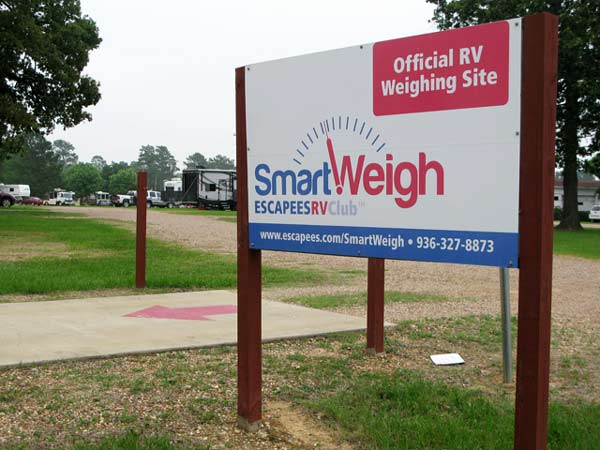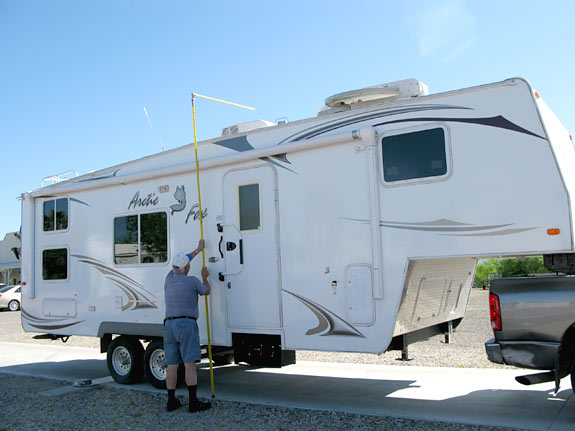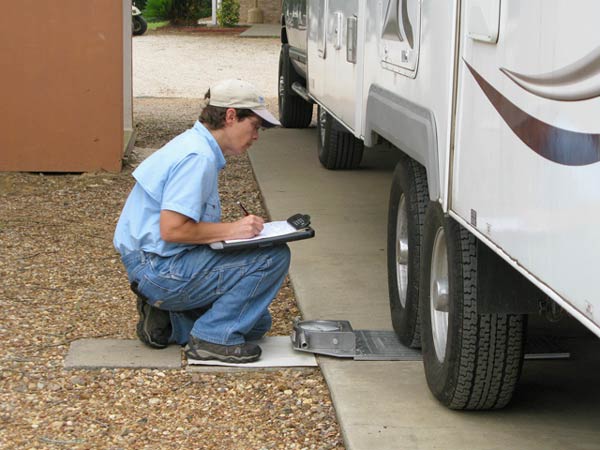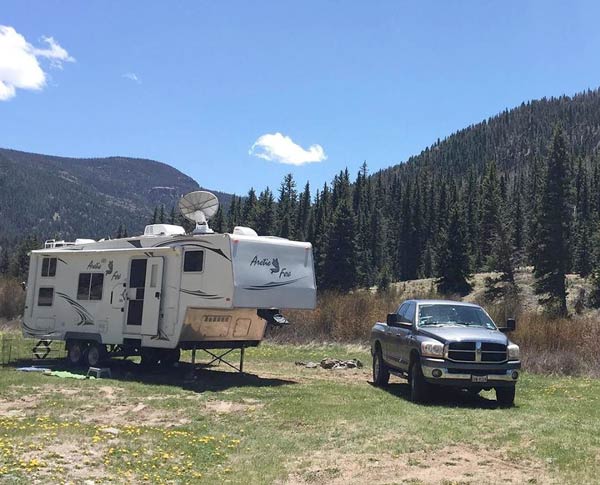Seems like we’re all wrestling with the “fit or fat” question. Whether it’s our bodies or our RVs, most of us carry too much weight around. When Jim and I upgraded to our bunkhouse fifth wheel, we had to be certain that our Dodge RAM 2500 diesel could safely tow it. We could have gotten weighed at a CAT scale like before, but now we know better. The only and best way to weigh your RV is to visit an official RV weighing site like those found at Escapees SmartWeigh.

Why CAT Scales Don’t Weigh Your RV Properly
Many RVers think that CAT scales are the best way to weigh your RV. We did too. But that’s just wrong. Don’t believe me? See what Escapees RV Club’s Smart Weigh program has to say:
“Truck scales are platform scales, which give you only the weight for the axle. Individual wheel weights are necessary to identify and resolve side-to-side balance and tire loading issues. Truck platform scales can actually give you a false “safe” indication and allow you to operate with one or more tires overloaded.”
Only RV weigh scales offer “wheel position weighing,” which gives the most complete and accurate picture of your RV weight. CAT truck stop scales only weigh each axle but RV scales weigh each wheel individually.

Escapees isn’t the only entity that says CAT scales are inadequate to weigh your RV. Here’s what the non-profit RV Safety and Education Foundation says:
- The ONLY way to properly weigh your RV is by wheel position. Your tires and wheels are the foundation of your RV, and each has a maximum weight rating.
- Unless you know the load being carried by each wheel position, you have no way to know the proper inflation of your tires. Improper inflation leads to improper wear, reduced life of the tire, and greater potential for rapid tire failure.
Knowing your weight will give you peace of mind. The fact is, overweight RVs are a hazard to you and anyone in your path.
- If you have an accident, your insurance policy and extended warranty carriers will void your coverage when they find out excess weight was to blame.
- Your legal and financial liability can bankrupt you if you hit someone with an overerweight RV. Injured parties can sue your pants off.
The RV Weigh-In, Part 1
As Escapees members since 2009, we knew about the Smart Weigh program but didn’t take advantage of it until we upgraded to our 27′ Arctic Fox fifth wheel bunkhouse. The first trip to the SmartWeigh Program in Congress Arizona happened shortly after adding a five-panel solar array, more (heavier) batteries and a whole lotta tools for my bunkhouse workshop. Until the day we arrived I constantly fretted: “Are we overweight?”

The Escapees Smart Weigh service is offered at three permanent locations in various club-owned parks. You can get weighed at the annual Escapade rally, but you’re better off with more individualized attention at park locations. Once your appointment is set, the process to weigh your RV is easy and fast:
- Load your rig exactly as it would be on the road. We had half-full water tanks, a few gallons in our black tank and a one week supply of food and consumables.
- Fill out forms that ask for your RV and tow vehicles’ tires’ make, model and specs.
- Drive to the scale and follow the weigh master’s instructions for positioning the rig. We drove the trailer onto two scales for each side of the rig, one weight per wheel.
- During the process the weighmaster will take a height measurement from the highest point of your rig (usually the air conditioner) to the ground.
- If you drive a towable RV or motorhome and toad, you’ll first weigh the RV and tow vehicle together, then you’ll unhitch and return only with your secondary vehicle for a separate reading.
During our weigh-in we learned from George the weigh master that over 50 percent of RVs he sees are overweight — many are dangerously overloaded. I wondered if we would be another statistic.

The good news; every corner of our Dodge and Arctic Fox was well within our cargo and towing capacities, with room to spare. We were safely within the Gross Combination Weight Rating and George actually thought we could stand to use a little more weight in the back of the rig for better load distribution.

The RV Weigh-in, Part 2
After adding our RV DataSat 840 to the roof — and experiencing two tire blow outs within nine months of getting weighed, I had to know: did we gain too much weight? I convinced Jim to have us weighed again, only this time at Rainbow’s End in Livingston.
We got onto the scale a second time. Only this time we did it with full water tanks. Our goal was to see how close to the edge taht would put us, because we often travel with full tanks when heading out to remote boondocking areas like Basin and Range.

The final results of our second weigh-in:
- With full tanks, we are maxing out the GVWR figures for our Dodge.
- Our weight load distribution was fine, but we acquired too much over the last year.
- Since both tire blowouts happened on the same side, it probably wasn’t related to uneven weight distribution.
- Our weigh master wasn’t overly concerned but did drive home the need to drop some poundage.
- She also recommended a heavier class of trailer tires.

Funny how weight just sort of creeps up on you, isn’t it? Over the last week I’ve ditched at least 20 pounds of stuff and there’s more that I know we can lose. The obsession to live lightly continues. . .